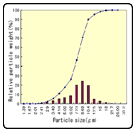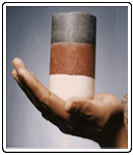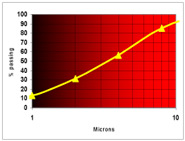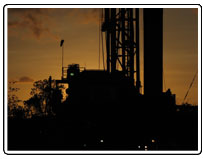Cemblend provides advanced cementing technologies including ceramic cements under the trade names of DuraSeal and Microceramic systems.
Ceramic cement generates less emissions during the production of the product, it recycles waste material by encapsulating other materials, and it protects the environment from the unwanted release of gas, drilling lossess, or water inflow.
Cemblend currently offers two products made with Ceramicrete: Microceramic and DuraSeal. Microceramic is an adjustable set time ceramic micro fine cement and DuraSeal is an ideal solution for controlling lost circulation and crossflows.
|
|
|
 The ReCeNT System The ReCeNT SystemCemblend Systems with Argonne National laboratory has created a novel solution that manages environmental concerns while simplifying wellbore logistics: The ReCeNT system. "Everyone Wins", from the Stakeholders to Shareholders. With the ReCeNT system, what comes out of the well goes back into the well. Drill cuttings are captured as a slurry and, when drilling is complete, a binder is added to the cuttings slurry and re-injected into the well along with an activator to cement the casing in place. This system substantially reduces water needs and at the same time, reduces both cuttings and mud disposal requirements. |
||
|
||
|
|
|
Portland cement is very dependent on density to gain strengths. However, strength is not always required during cement placement. Ceramicrete can have preset strengths independent of density which allows for high strength, lightweight cement slurries as well as low strength, high density slurries and vise versa. |
|
|
|
Ceramicrete also has the added advantage of being able to 'activate on the fly'. "Because we are aggressive with the mix, it would be a concern to mix the ceramic in a pumping unit and have it set early on the truck. But because we activate the material as it is being placed, we have a lot more control of where the product sets," says Getzlaf the President of Cemblend Systems Inc.
The major advantages of Ceramicrete is that it can bond to steel, cement, formations, and even itself. "Ceramicrete's ability to bond allows for substantially improved performance in wellbores with drastic temperature changes and/or pressure changes. This 'stictivity' also aids in making sure the cement stays bonded to the wellbore formations as conditions change." says Getzlaf the President of Cemblend Systems Inc..
|


 Microceramic
Microceramic DuraSeal
DuraSeal MC2
MC2
 High end fluid loss additive and suspending aid.
High end fluid loss additive and suspending aid.  Polypropylene fibers designed specifically for lost circulation and ease of mixing.
Polypropylene fibers designed specifically for lost circulation and ease of mixing.

 The significant difference between Portland cement and Ceramicrete is that Portland cement is not
compatible with oil or organic materials. These materials typically slow or stop
the setting process of the Portland cement. "We're seeing a trend where industry
is drilling more with hydrocarbon-based drilling fluids and it is very difficult
to stop contamination between the cement and these materials. Ceramicrete encapsulates
organic material and therefore the organic materials have a minimal effect on the
set time of Ceramicrete. This means Ceramicrete can be placed in some very difficult
environments and still have a consistent setting," says Getzlaf the President of Cemblend Systems Inc..
The significant difference between Portland cement and Ceramicrete is that Portland cement is not
compatible with oil or organic materials. These materials typically slow or stop
the setting process of the Portland cement. "We're seeing a trend where industry
is drilling more with hydrocarbon-based drilling fluids and it is very difficult
to stop contamination between the cement and these materials. Ceramicrete encapsulates
organic material and therefore the organic materials have a minimal effect on the
set time of Ceramicrete. This means Ceramicrete can be placed in some very difficult
environments and still have a consistent setting," says Getzlaf the President of Cemblend Systems Inc..

 The benefits of Ceramicrete are that the set time can be changed independent of
temperature, the strengths can be changed independent of density, and the particle
size can be changed independent of all other parameters. These three abilities give
drilling operators total control of product selection independent of the wellbore
temperature, permeability, or pressures.
The benefits of Ceramicrete are that the set time can be changed independent of
temperature, the strengths can be changed independent of density, and the particle
size can be changed independent of all other parameters. These three abilities give
drilling operators total control of product selection independent of the wellbore
temperature, permeability, or pressures.
 One of the biggest benefits of using Ceramicrete is its ability to set hardening
times independent of temperatures. What does this mean for drilling operators? "This
means a shorter waiting time at the surface of the well. It means quicker setting
cement can reduce the chances of gas migration through the cement. It means that
once the cement is placed, it remains were it is placed and will not migrate away
from the wellbore. It means the cement is less susceptible to mixing with either
wellbore contaminants or formation contaminants," says Getzlaf the President of Cemblend Systems Inc.
One of the biggest benefits of using Ceramicrete is its ability to set hardening
times independent of temperatures. What does this mean for drilling operators? "This
means a shorter waiting time at the surface of the well. It means quicker setting
cement can reduce the chances of gas migration through the cement. It means that
once the cement is placed, it remains were it is placed and will not migrate away
from the wellbore. It means the cement is less susceptible to mixing with either
wellbore contaminants or formation contaminants," says Getzlaf the President of Cemblend Systems Inc.
 Ceramicrete is currently being used in the lost circulation and gas migration markets
and Cemblend has plans to move its products into both the thermal and CO2 markets. These
extreme environments are perfect candidates for utilizing the ceramic technology's
attributes of temperature and corrosion resistance, thus providing another tool in
total wellbore management.
Ceramicrete is currently being used in the lost circulation and gas migration markets
and Cemblend has plans to move its products into both the thermal and CO2 markets. These
extreme environments are perfect candidates for utilizing the ceramic technology's
attributes of temperature and corrosion resistance, thus providing another tool in
total wellbore management.